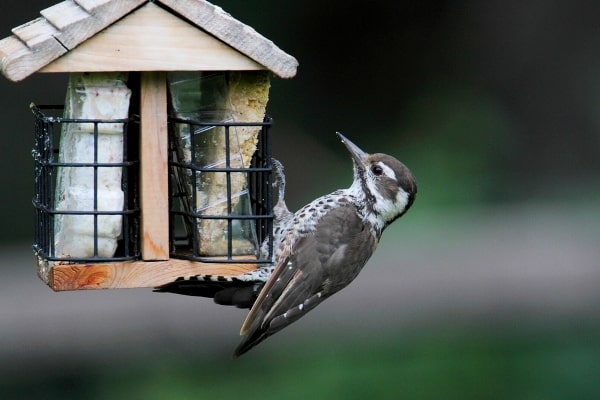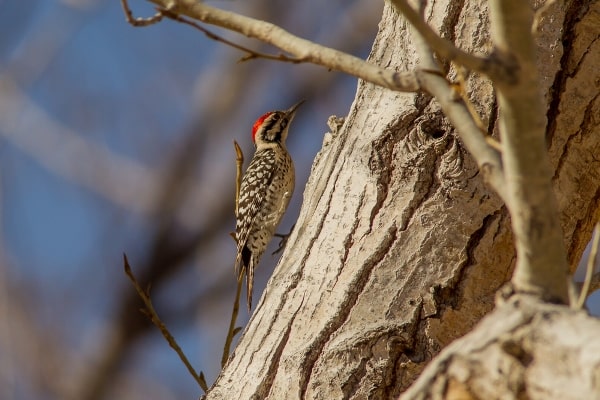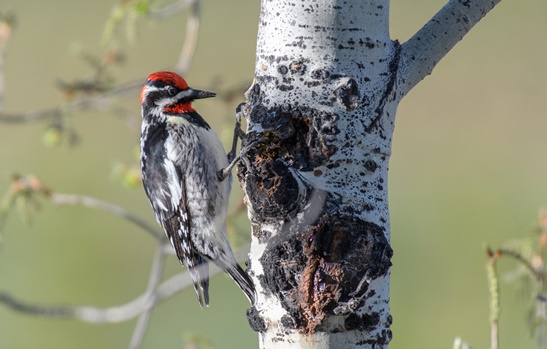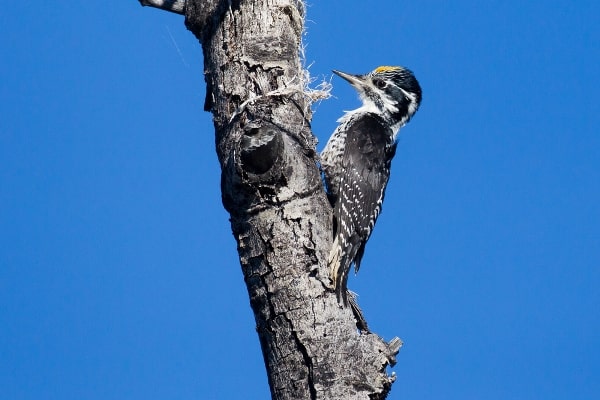At the southern end of the Rocky Mountain range sits beautiful New Mexico. Whether you enjoy hiking, mountain biking, skiing, water sports, ghost town hunting, or just exploring the great American southwest, New Mexico has it all.
The state is also home to 12 different species of woodpeckers, one of which is only found in two states in the US.
Everyone from people living in the suburbs of Albuquerque to tourists visiting the historic adobe buildings in Taos can spot numerous different woodpeckers in New Mexico.
If you want to add all 12 to your life list, you might need to be patient, but it’s totally possible. Just break out the hiking boots, fill your canteen, and polish up those binoculars.
Here is the list of species of woodpeckers in New Mexico:
- Downy Woodpecker
- Hairy Woodpecker
- Arizona Woodpecker
- Ladder-backed Woodpecker
- Northern Flicker
- Acorn Woodpecker
- Gila Woodpecker
- Lewis’s Woodpecker
- Williamson’s Sapsucker
- Red-naped Sapsucker
- Red-Headed Woodpecker
- American Three-toed Woodpecker
12 Woodpeckers in New Mexico
1. Downy Woodpecker

Scientific name: Dryobates pubescens
Size: 7 inches long
Weight: 0.75-0.99 ounces
Wingspan: 10-12 inches
The smallest woodpecker species in the US, the downy woodpecker lives across New Mexico, which is the southern part of its range. They don’t migrate but stay in place all year.
You can find this petite woodpecker in the mountains, cities, and suburban yards of New Mexico. In the winter, they hang out with chickadees and nuthatches, and they build their nests in the cavity of trees.
They are black and white overall, with distinct spotted wings and a white breast. Adult males sport a bright red cap on the back of their heads.
If you dream of watching the behavior of these common birds, put a suet feeder in your yard. They love them and aren’t afraid to come to hang out for a bit so that you can watch them.
Because of their small size, they’re able to access parts of the tree or land on small stems of plants to hunt for food. They’re also small enough that they often make nests in the wood siding of homes.
2. Hairy Woodpecker

Scientific name: Picoides villosus
Size: 7.5 inches
Weight: 1.4-3.4 ounces
Wingspan: 13-16 inches
Hairy woodpeckers are sometimes confused with downy woodpeckers because they’ll look incredibly similar. You can tell them apart because they’re larger than their cousins. They have a long bill, almost the length of their head, which further sets them apart from downy woodpeckers.
They are black and white all over their bodies. You can tell the genders from one another because the adult males have a little red spot on the back of their heads.
These pretty woodpeckers aren’t as common in cities as downy woodpeckers, but you will see them in parks, suburban areas, cemeteries, and other quiet wooded or open areas. They will also visit suet feeders. Downy woodpeckers live throughout New Mexico, but you don’t see them as much in the eastern edge of the state.
Hairy woodpeckers don’t migrate, and they make nests in the cavities of dead trees. Research published in The Journal of Wildlife Management found that they prefer forests that have recently burned.
Populations have been declining in recent years as they lose habitat, but they also face pressure from invasive birds like European starlings, which will take over their nests.
3. Arizona Woodpecker

Scientific name: Dryobates arizonae
Size: 7.1.7.9 inches
Weight: 1.2-1.8 ounces
Wingspan: 14 inches
The Arizona woodpecker only lives in two states in the US, and one of those is New Mexico (the other is Arizona). It lives in the southwestern part of New Mexico. Its range extends south into Mexico.
The Arizona woodpecker stands out from other woodpeckers in New Mexico because it is primarily brown rather than black. It has a spotted and barred belly that is brown and cream. The males have a red crown, and the females have a brown cheek patch (but they don’t have any red).
This exciting bird starts at the bottom of a tree and works its way up in a spiral pattern, searching for insects. During the winter, you’ll often see them hanging out with flocks of other species.
One Arizona woodpecker was once spotted hammering on the leg of a horse looking for a tasty treat. It kept pursuing the horse even after it walked off!
4. Ladder-Backed Woodpecker

Scientific name: Dryobates scalaris
Size: 6.3-7.1 inches
Weight: 0.7-1.7 ounces
Wingspan: 13 inches
Across the arid desert of the southwestern US live the Ladder-backed woodpecker. These tiny foragers flit among the cacti to find food, and they’ll also visit feeders that have mealworms or black oil sunflower seeds.
They’re black and white with white bars across the wings and back that look very much like a ladder. The chest is spotted black and white. The males have a red crown.
While other woodpecker species that make their home in the desert need large plants to make a nest in, these petite little birds can live in the scrub and shrubs. They’re a close relative of the Nutall’s woodpecker.
Look for the ladder-backed woodpecker during the late winter and early spring in New Mexico. They’re less common in the west and north parts o the state, but you can still see them if you look carefully.
5. Northern Flicker

Scientific name:
Size: 11-12 inches
Weight: 4-6.5 ounces
Wingspan: 16.5-20 inches
The beautiful northern flicker lives in open habitats near trees, as well as in parks and cemeteries. They are a frequent visitor to suet feeders in suburban and urban yards. Unlike some woodpeckers, they like to hunt around on the ground rather than in the trees.
The males, females, and juveniles vary in appearance. They are brown in color overall, with black spots. The underside of the wings and tails are yellow in the eastern half of the US and red in the western half of the US.
Some have a red or black stripe on their cheeks, and many of them have large, black crescents on their chest. Others have red marks on the back of the head. Some have a slightly gray head.
In the spring, the calls of Northern flickers can be heard for miles. It’s a distinctive sound and easy to identify once you know their calls and drumming.
They primarily eat ants, but they’ll also munch on other insects such as caterpillars, beetles, and termites. There are also reports that they are capable of catching young bats as they leave the nest. You can entice them to come to your yard by offering a suet feeder.
Flickers who live in Alaska and Canada will migrate to areas that have higher temperatures in the south during the winter.
Studies show that Northern Flickers can lose their nests to invaders like European starlings.
6. Acorn Woodpecker

Scientific name: Melanerpes formicivorus
Size: 7.5-9 inches
Weight: 2.3-3.2 ounces
Wingspan: 14-17 inches
Acorn woodpeckers are often described as having the face of a clown because they have a black mouth surrounded by a white border and black over their eyes. They have a red cap, a black body, and a white patch on the rear and on each wing. The chest is slightly gray or white.
These woodpeckers live in evergreen forests on the west coast and in a few parts of the southwest, including New Mexico. They live in the state year-round.
These birds collect acorns and fill holes in trees full of the collected nuts. These caches of nuts can be used by generations of woodpeckers and one tree may contain up to 50,000 holes.
In addition to acorns, they also eat insects, especially ants, as well as seeds, nuts, and sometimes the eggs of other birds.
This is one of the few species that prefers to live in small colonies rather than alone, and studies reveal that they do this to help one another raise young, a practice called cooperative breeding.
7. Gila Woodpecker

Scientific name: Melanerpes uropygialis
Size: 8.7-9.4 inches
Weight: 1.8-2.8 ounces
Wingspan: 15.8-16.5 inches
In Southern California, Arizona, and a small section of southwest New Mexico lives the Gila woodpecker. This bird makes its home in the arid deserts of southern North America where it makes its nest in dead trees or living saguaro cacti. They eat insects and fruit, and they’ll also nibble on nuts and seeds in backyard feeders.
The birds have a tan head and belly and black and white striped wings. Males have a red crown, but females and juveniles do not. They’re very territorial and will chase off swallows, wrens, and European starlings.
8. Lewis’s Woodpecker

Scientific name: Melanerpes lewis
Size: 10.2-11 inches
Weight: 3.1-4.9 ounces
Wingspan: 19-.20.5 inches
This medium-sized bird lives across the western half of the US, migrating from the northern part of the country to the southern part during the winter. They don’t dig or peck into the wood, but find insects crawling around on the bark.
These pretty woodpeckers are green and pink with a red face and white neck, which makes them stand out among other species. It also likes to catch insects mid-air while they’re flying, which sets it apart from other birds. That’s something most woodpeckers don’t do, for the most part.
As fall comes around, this industrious bird collects acorns and other nuts and stuffs them into cavities in trees so that they have food for later.
Pairs mate for life and make nests in excavated trees or utility poles. While they aren’t one of the most common woodpeckers in New Mexico, you can see them all year-round.
9. Williamson’s Sapsucker

Scientific name: Sphyrapicus thyroideus
Size: 8.3-9.8 inches
Weight: 1.6-1.9 ounces
Wingspan: 17 inches
Like other sapsuckers, this one drills small holes into trees. Then they wait for the sap to start leaking out and they drink it. They also eat ants and other small insects.
They prefer coniferous forests and they live in the mountains of western North America. They spend their time in the higher elevation forests and drop down to lower elevations during the winter. However, in the 1990s, scientists found that this sapsucker had extended its range as far south as Baja California.
They don’t visit the eastern third of New Mexico too often, but you can regularly see this woodpecker in the rest of New Mexico.
Large for a sapsucker, the males are mostly black with white patches on the wings and a red throat. The females have horizontal barring on their backs. They also have a brown head. The sexes appear so different from one another that scientists originally thought that they were different species.
The males carve out holes in trees to create a nest for the female to lay her eggs in.
10. Red-Headed Woodpecker

Scientific name: Melanerpes erythrocephalus
Size: 7.5-9.1 inches
Weight: 2.0-3.2 ounces
Wingspan: 16.5 inches
Red-headed woodpeckers are very striking. They have solid black wings with a big white patch, and white bodies. To top it off, a deep, dark red head and neck that is so vibrant it looks like velvet. The juveniles are brownish-black with white spots on the wings and dull red cheeks.
They don’t usually cross west of the Rocky Mountains, but they can be found in all parts east, from Canada to Florida. They winter in Texas and northern Mexico and breed in the northern end of the US and southern Canada.
But every once in a while, you might get lucky and spot the red-headed woodpecker in New Mexico during the breeding season. It’s not common, but it’s possible.
It’s one of the few woodpeckers out there who like to store food for the winter. They stuff seeds and nuts in bark or holes in trees. They have even been known to stuff food under shingles.
They also hunt their prey, snatching insects out of the air, which is another rare behavior for woodpeckers.
11. Red-naped Sapsucker

Scientific name: Sphyrapicus nuchalis
Size: 7.5-8.3
Weight: 1.1-2.3 ounces
Wingspan: 16-16.9 inches
As the name suggests, this bird has a thing for the sap in trees. It will tap little holes into the bark so that sugary sap runs out and it can eat it. They particularly love aspen, pine, and birch trees. They’ll even nest in backyards that have those trees, and they will stop and visit if you provide them with a suet feeder.
If you see rows of holes drilled into pine, birch, or aspen trees, keep a sharp eye out because they’re likely to be around.
They have vertical white patches that you can only see when the wing is folded. They have black and white striped bodies and heads, and a bright red cap and throat, though some females have a white throat.
This is a close relative of the red-bellied sapsucker and the yellow-bellied sapsucker. They all look fairly similar.
Look for these woodpeckers in the north part of New Mexico during the breeding season and in the south and western parts during the winter.
12. American Three-Toed Woodpecker

Scientific name: Picoides dorsalis
Size: 8.3-9.1 inches
Weight: 1.6-2.4 ounces
Wingspan: 14.6-15.3 inches
This woodpecker primarily makes Canada its home, but you will rarely see it pop down to North Dakota, Michigan, and Maine. It also lives year-round in western parts of the country, including Idaho, Utah, Colorado, New Mexico, and Oregon. They’re fairly uncommon, but you can see them if you watch carefully.
This bird likes to hunt in burned-out areas and forests where beetles have killed lots of trees. It hunts for insects, pulling and stripping away bark until it finds what it is looking for.
Yes, this bird only has three toes, but you’ll most easily be able to identify it by its coloring. It’s primarily black but it does have white barring on its sides and back, and the chest is white. The male has a bright yellow crown.
Also Read: Owls in New Mexico
